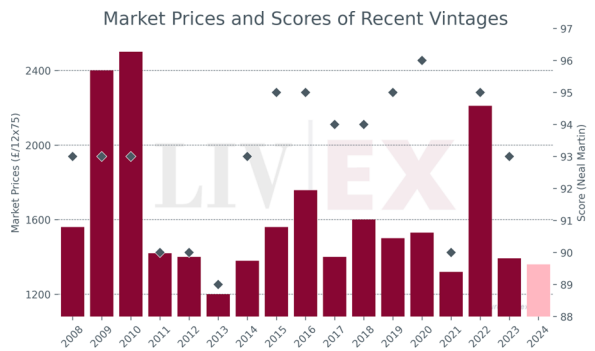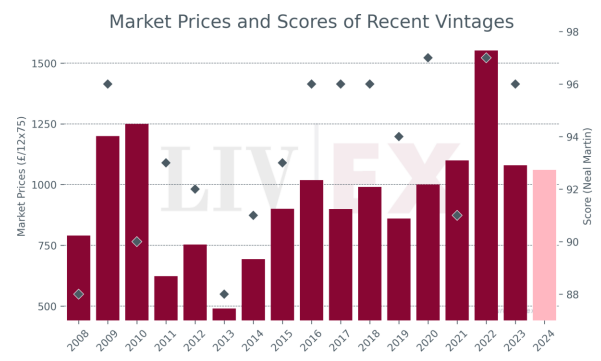Latour 2012 will be released onto the market on March 18th. The chateau opted out of the En Primeur system in 2012 following the release of its 2011 vintage. Since then, it has re-released a number of vintages (2008 and 2011 being the latest), with ex-chateau provenance used to justify price tags higher than the market price.
Pricing details of the new release have not been disclosed. Frédéric Engerer, Château Latour’s president and CEO, has said that ‘the 2012 grand vin release will be the largest in terms of volume’ since leaving En Primeur but that the estate would also hold back stock for the future. The market is expecting at least 6,000 cases to be released.
Prices for Latour have historically shown 83% correlation to Wine Advocate scores. According to Liv-ex’s ‘Fair Value’ methodology, which measures the relationship between critic scores and Market Price using regression analysis, the 2012 (LPB 96+) should be released in the UK at around the £5,000 mark. For followers of Neal Martin, who awarded the wine slightly higher 97 points when writing for the Wine Advocate, a price tag closer to £5,500 would still represent fair value. However, it is interesting to note that ‘off’ vintages of Latour in the secondary market tend to carry a price tag closer to £4,500.

But there are other factors at play. Provenance and the allure of the first ‘new’ release since 2011 will likely have an influence on demand. The elimination of storage costs and buying a “ready to drink” wine in bottle rather than en primeur, in theory, add to the allure.
Against this is the challenging market landscape. Bordeaux has been losing market share (so far in 2020 holding below 50%) and the Bordeaux 500 index has fallen 3.6% over the past year. The Liv-ex 50, which measures the price movements of the First Growths, has dipped 5.7% over the same period.
Headwinds affecting the wine world have impacted Bordeaux. US tariffs have kept American buyers at bay. The outbreak of the Covid-19 has stirred markets, with sterling being hit hard by investors’ risk aversion. Global trade events have been cancelled and many have questioned whether this year’s En Primeur would go ahead as planned despite assurance from the UGC.
Then there is the broader question as to whether the Latour release policy has worked for collectors. There is little doubt that releasing the 2012 now allows the Chateau to take advantage of a market that has risen 18% over the past seven years. Margaux, Mouton and Haut Brion released their 2012s on to the international market at £2,800, Lafite at £4,000.
Latour’s en primeur releases have provided great returns for collectors: in the case of the 1996 vintage, prices have risen over 400%. The returns on the re-releases have been far more chequered. The problem resides in that the market soon discounts the “ex chateau” premium, settling instead at the secondary market level, which after all, reflects the reality of the day for “ex chateau” stock.

Along with the Grand Vin, a portion of the 2014 Les Forts de Latour and the 2015 Pauillac de Latour are due to be released next week. The wines will be distributed around the world via selected négociants on the Place de Bordeaux.
* UPDATE – This post was published on the 12th March, when the upcoming Latour release was still scheduled for 18th March. However, in light of ongoing uncertainties surrounding Covid-19, it has been reported that Latour 2012 will no longer be released this week but instead postponed until later this year.



